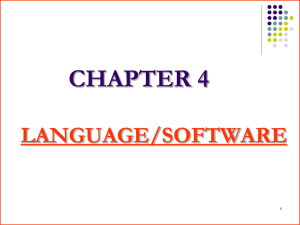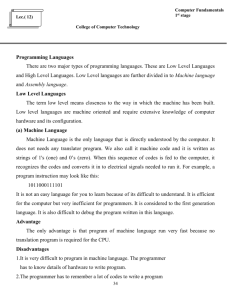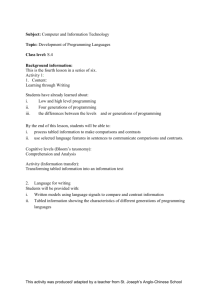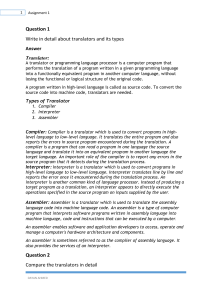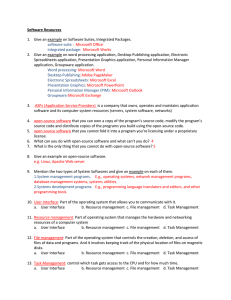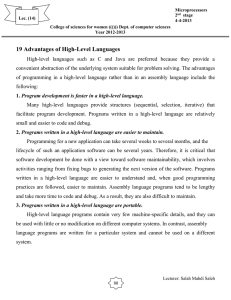COMPUTER LANGUAGES
advertisement
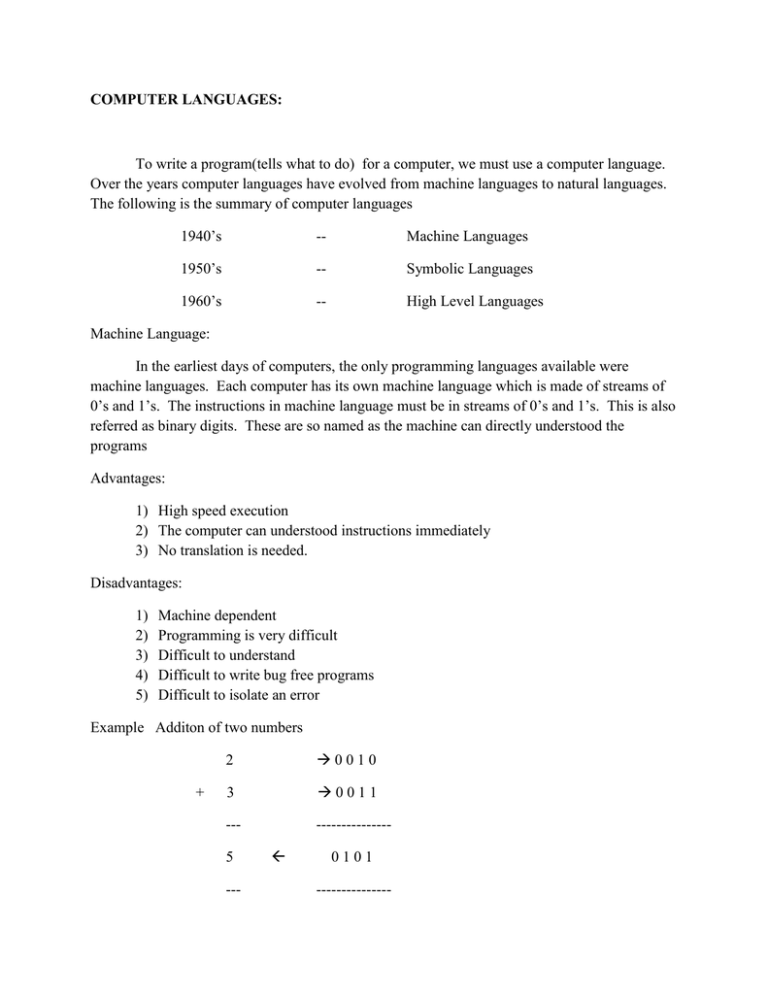
COMPUTER LANGUAGES:
To write a program(tells what to do) for a computer, we must use a computer language.
Over the years computer languages have evolved from machine languages to natural languages.
The following is the summary of computer languages
1940’s
--
Machine Languages
1950’s
--
Symbolic Languages
1960’s
--
High Level Languages
Machine Language:
In the earliest days of computers, the only programming languages available were
machine languages. Each computer has its own machine language which is made of streams of
0’s and 1’s. The instructions in machine language must be in streams of 0’s and 1’s. This is also
referred as binary digits. These are so named as the machine can directly understood the
programs
Advantages:
1) High speed execution
2) The computer can understood instructions immediately
3) No translation is needed.
Disadvantages:
1)
2)
3)
4)
5)
Machine dependent
Programming is very difficult
Difficult to understand
Difficult to write bug free programs
Difficult to isolate an error
Example Additon of two numbers
+
2
0010
3
0011
---
---------------
5
---
0101
---------------
Symbolic Languages (or) Assembly Language:
In the early 1950’s Admiral Grace Hopper, a mathematician and naval officer, developed
the concept of a special computer program that would convert programs into machine language.
These early programming languages simply mirrored the machine languages using symbols or
mnemonics to represent the various language instructions. These languages were known as
symbolic languages. Because a computer does not understand symbolic language it must be
translated into the machine language. A special program called an Assembler translates
symbolic code into the machine language. Hence they are called as Assembly language.
Advantages:
1)
2)
3)
4)
Easy to understand and use
Easy to modify and isolate error
High efficiency
More control on hardware
Disadvantages:
1)
2)
3)
4)
5)
Machine Dependent Language
Requires translator
Difficult to learn and write programs
Slow development time
Less efficient
Example:
2
PUSH 2,A
3
PUSH 3,B
+
ADD A,B
5
PRINT C
HIGH-LEVEL Languages:
The symbolic languages greatly improved programming efficiency they still
required programmers to concentrate on the hardware that they were using working with
symbolic languages was also very tedious because each machine instruction had to be
individually coded. The desire to improve programmer efficiency and to change the focus from
the computer to the problems being solved led to the development of high-level languages.
High-level languages are portable to many different computer allowing the programmer
to concentrate on the application problem at hand rather than the intricacies of the computer.
C
C++
JAVA
A systems implementation Language
C with object oriented enhancements
Object oriented language for internet and general applications using basic C syntax
Advantages:
1)
2)
3)
4)
5)
6)
7)
8)
Easy to write and understand
Easy to isolate an error
Machine independent language
Easy to maintain
Better readability
Low Development cost
Easier to document
Portable
Disadvantages:
1)
2)
3)
4)
Needs translator
Requires high execution time
Poor control on hardware
Less efficient
Example:
C language
#include<stdio.h>
void main()
{
int a,b,c;
scanf("%d%d%",&a,&b);
c=a+b;
printf("%d",c);
}
Difference between Machine ,Assembly, High Level Languages
Feature
Form
Machine Dependent
Translator
Execution Time
Languages
Nature
Memory Space
Machine
0’s and 1’s
Dependent
Not Needed
Less
Only one
Difficult
Less
Assembly
Mnemonic codes
Dependent
Needed(Assembler)
Less
Different Manufactgurers
Difficult
Less
High Level
Normal English
Independent
Needed(Compiler)
High
Different Languages
Easy
More
Language Translators
These are the programs which are used for converting the programs in one language into
machine language instructions, so that they can be excuted by the computer.
1)
2)
3)
Compiler:
It is a program which is used to convert the high level language
programs into machine language
Assembler: It is a program which is used to convert the assembly level
language programs into machine language
Interpreter: It is a program, it takes one statement of a high level language
program, translates it into machine language instruction and then immediately
executes the resulting machine language instruction and so on.
Comparison between a Compiler and Interpreter
COMPILER
A Compiler is used to compile an entire
program and an executable program is
generated through the object program
The executable program is stored in a disk for
future use or to run it in another computer
The compiled programs run faster
Most of the Languages use compiler
INTERPRETER
An interpreter is used to translate each line of
the program code immediately as it is entered
The executable program is generated in RAM
and the interpreter is required for each run of
the program
The Interpreted programs run slower
A very few languages use interpreters.


